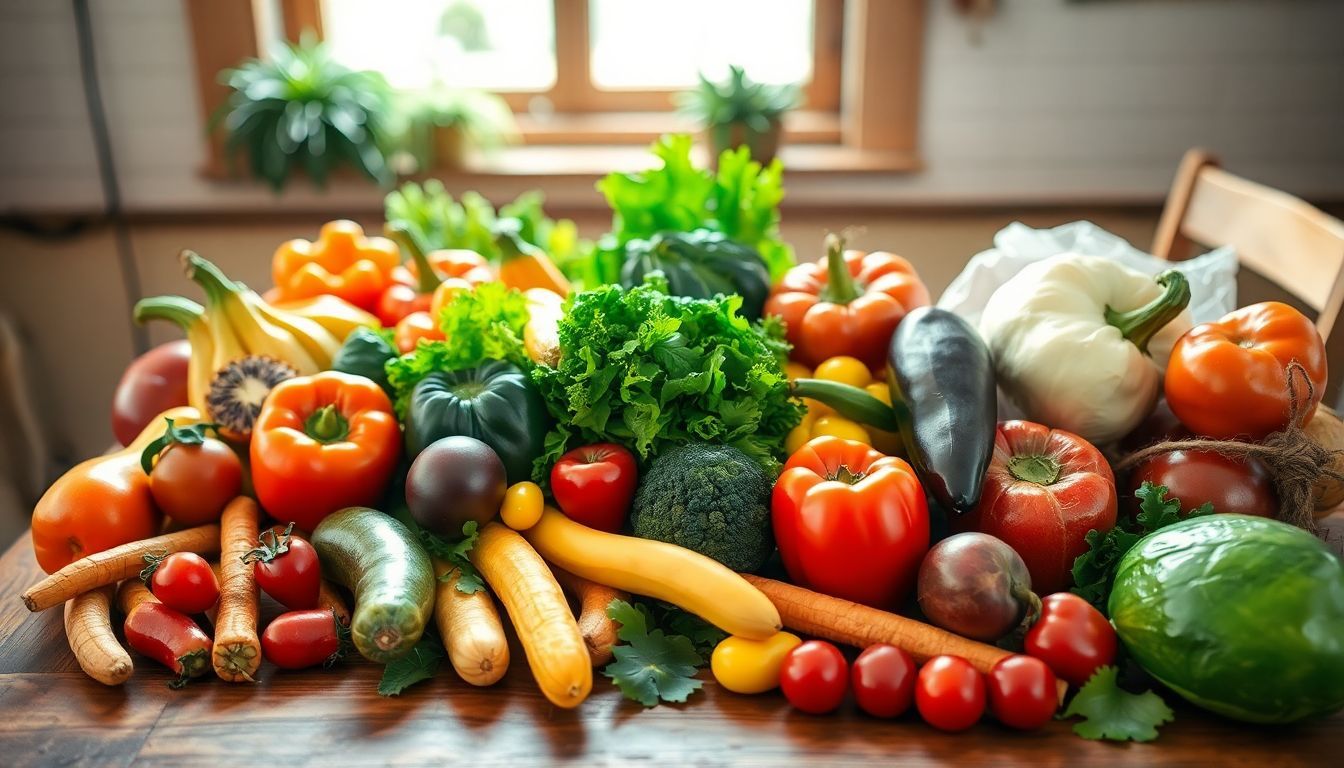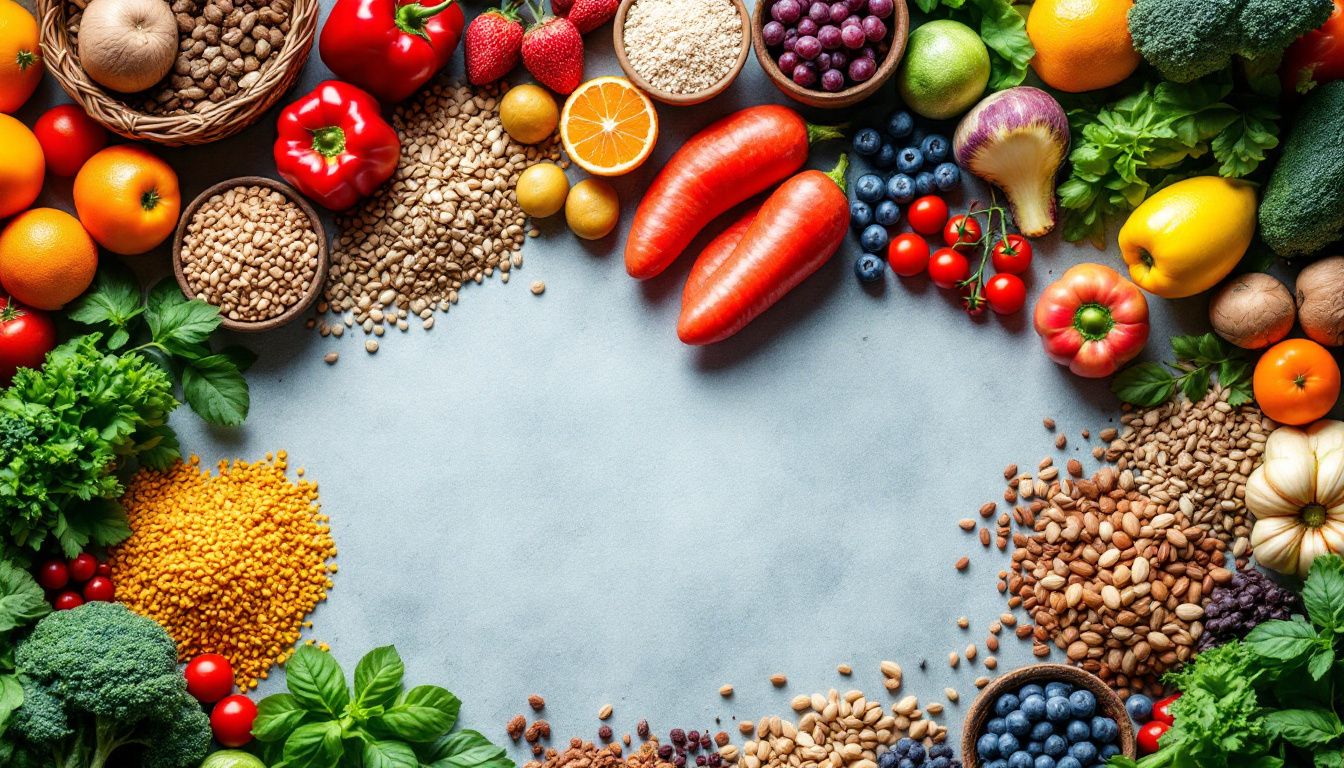Managing type 2 diabetes can feel overwhelming, especially with so many food choices. Did you know certain foods can help regulate blood sugar levels and even improve heart health? This blog will guide you through the best foods to include in your diet for better blood sugar control.
Thank you for reading this post, don't forget to subscribe!Keep reading to eat smarter and feel healthier!
Key Takeaways
- Non-starchy vegetables like broccoli, spinach, and carrots are low in carbs and should fill half your plate. Aim for at least six servings daily to improve blood sugar and heart health.
- High-fiber foods such as berries, whole grains, beans, and lentils help control blood sugar by slowing digestion. Red raspberries can lower post-meal insulin spikes when eaten with high-carb meals.
- Foods rich in omega-3s—like salmon, walnuts, flaxseeds, and chia seeds—support heart health and regulate glucose levels. Eating 26 ounces of fatty fish weekly improves blood sugar after meals.
- Replace refined grains (white rice) with whole grains (brown rice or barley) to prevent sudden spikes in blood sugar levels. Daily intake of 60–90 grams cuts type 2 diabetes risk by up to 32%.
- Limit sugary snacks like candy or processed meats high in saturated fats to avoid worsening insulin sensitivity or harming the heart over time. Opt for lean proteins instead like chicken breast or tuna.
Essential Foods for Managing Type 2 Diabetes
Eating the right foods can help manage blood sugar levels and support overall health. Focus on nutrient-rich options that keep you full and energized.
Non-starchy vegetables
Non-starchy vegetables help control blood sugar levels. They are low in calories and carbs but rich in fiber, vitamins, and minerals. Options like broccoli, spinach, peppers, and carrots fit perfectly into a healthy diet for people with type 2 diabetes.
These should fill half your plate during meals as recommended by the Diabetes Plate Method.
A serving is just 1/2 cup of cooked veggies or one full cup of raw ones. Aim for at least six servings daily to improve heart health and insulin sensitivity while lowering high blood pressure risks.
Frozen or canned options labeled “no salt added” are great choices too—easy to store and use without sacrificing nutrition!
High-fiber fruits
Berries and citrus fruits pack fiber and vitamins, making them great for a diabetes-friendly diet. Eating high-fiber fruits helps control blood sugar levels and supports weight loss.
For example, a 2019 study revealed that eating 250 grams of red raspberries with a high-carb meal lowered post-meal insulin and blood sugar. Whole fruits are better than fruit juices since they provide more fiber.
These natural options also aid digestion, reduce the glycemic index impact, and keep you full longer. Apples, pears, oranges, and blueberries are excellent choices for daily meals or snacks.
This helps people with diabetes balance their blood sugar while enjoying tasty foods!
Whole grains
High-fiber fruits help control blood sugar, but whole grains are another powerful ally. Foods like barley, oats, and whole wheat offer complex carbohydrates that break down slowly.
This helps prevent sudden spikes in blood sugar levels. Eating 60 to 90 grams of whole grains daily can cut the risk of type 2 diabetes by up to 32%.
Swapping white rice for brown rice or bulgur makes a big difference. Whole grains also improve metabolic health and support weight loss efforts, especially for those who are overweight.
Barley and oats have shown strong benefits in managing blood sugar regulation too!
Lean proteins
Lean proteins help control blood sugar levels and support weight loss. Skinless chicken, fish like salmon or tuna, eggs, and plant-based options such as black beans and lentils are excellent choices.
These foods provide necessary vitamins and minerals without adding saturated fats or trans fats to your diet.
The Diabetes Plate Method suggests filling one-quarter of your plate with protein-rich foods for balanced eating. Including sources like fatty fish also adds omega-3 fatty acids, which boost heart health.
Up next—superfoods that pack a punch for better diabetes care!
Superfoods for Blood Sugar Control
Certain foods can help keep blood sugar levels steady and support overall health—explore these nutritious options to take charge of your diabetes diet.
Broccoli and broccoli sprouts
Broccoli and its sprouts can help control blood sugar levels. They contain sulforaphane, a compound that may improve health in people with type 2 diabetes. In a 12-week study, obese adults with diabetes showed lower fasting blood sugar after consuming broccoli sprout extract.
This benefit makes them a great addition to any healthy diet.
Sulforaphane is also linked to better heart health as it lowers high blood sugar—a risk for heart disease. These vegetables are rich in dietary fiber too, which aids digestion and improves insulin sensitivity.
Pair broccoli or its sprouts with other diabetes-friendly foods like lean protein or whole grains for added benefits… Next up: the wonders of seafood!
Seafood
Fatty fish like salmon, herring, mackerel, and sardines are rich in omega-3 fatty acids. These healthy fats improve heart health and may help lower cholesterol levels. Eating 26 ounces (750 grams) of fatty fish weekly can improve blood sugar after meals.
Aim for at least two servings each week.
Choose broiling, baking, or grilling to cook seafood without adding unhealthy fats. Fatty fish supports insulin sensitivity and helps with disease control. It’s a great lean protein choice for managing diabetes while boosting overall health.
Nuts and seeds
Seafood provides omega-3 fatty acids, but nuts and seeds also pack a punch for healthy fats. An ounce of almonds or walnuts delivers magnesium, fiber, and unsaturated fats. These nutrients help with blood sugar regulation and insulin sensitivity.
Walnuts and flaxseeds stand out as excellent sources of omega-3s.
Pumpkin seeds show great potential too. A 2018 study revealed that eating 2 ounces (about 65 grams) after meals reduced blood sugar by up to 35%. Chia seeds and sunflower seeds also provide fiber-rich benefits that improve heart health—a crucial focus in diabetes management.
Beans and lentils
Beans and lentils pack a punch with fiber, magnesium, and protein. These nutrients help regulate blood sugar levels. They contain soluble fiber and resistant starch, which slow digestion.
This keeps post-meal spikes under control. Black beans, kidney beans, and pinto beans are great choices.
Regularly eating these can prevent type 2 diabetes. A cup of cooked lentils offers about 15 grams of dietary fiber—nearly half your daily need! They also support weight loss by keeping you full longer.
Add them to soups or salads for heart health benefits too!
Berries
Berries pack a punch with vitamins C and K, manganese, potassium, and fiber. They are rich in antioxidants which help your body fight damage from harmful molecules. A 2019 study showed eating 250 grams of red raspberries during a high-carb meal lowered both postmeal blood sugar and insulin levels.
These fruits are sweet but have no added sugars. Berries like strawberries, blueberries, or raspberries make great diabetes-friendly snacks or dessert options. Their natural sweetness can satisfy cravings without spiking blood sugar levels.
Plus, they support heart health and improve overall metabolic syndrome management.

Foods to Incorporate Regularly
Adding nutrient-rich foods to your meals can help support blood sugar control and overall health—learn how these choices can fit into your daily routine.
Chia seeds and flaxseeds
Chia seeds and flaxseeds help manage blood sugar levels. The fiber in chia seeds slows food digestion, lowering sugar spikes after meals. Flaxseeds are rich in lignans, which may improve insulin sensitivity.
Studies show these seeds can reduce post-meal glucose levels.
Both are easy to add to meals. Sprinkle them on oatmeal or mix them into smoothies for a healthy boost. They also work well in baked goods like muffins or bread. These tiny seeds enhance diet quality while keeping blood sugar stable.
Pumpkin and pumpkin seeds
Pumpkin and pumpkin seeds are packed with fiber and antioxidants. These nutrients support blood sugar regulation. Studies show polysaccharides in pumpkin may help control sugar levels.
For example, a 2018 study revealed eating 2 ounces of pumpkin seeds reduced post-meal blood sugar by up to 35%.
Pumpkin extracts or powders also lower blood sugar significantly. Adding roasted pumpkin seeds to salads or oatmeal makes for a healthy snack. They’re rich in magnesium too, which improves insulin sensitivity.
Kale and other leafy greens
After savoring pumpkin seeds rich in nutrients, don’t forget leafy greens like kale. Kale is bursting with vitamins A, C, K, and folate. It also offers minerals such as calcium, iron, and potassium.
This makes it a powerhouse for overall health and diabetes management.
Low in calories and carbs, kale helps keep blood sugar levels steady. Dark green leafy vegetables should fill half your plate based on the Diabetes Plate method. Add them to soups or salads for an easy nutrient boost!
Citrus fruits
Citrus fruits like oranges, grapefruits, lemons, and limes are full of vitamin C. This nutrient helps boost your immune system and supports heart health. They also have fiber, folate, and potassium—all important for managing blood sugar levels.
Whole citrus fruits work better than juices because they keep the fiber intact. Fiber slows sugar absorption and may improve insulin sensitivity. Try adding orange slices to a salad or using lime juice in dressings for extra flavor without added sugars.
Avocados
Avocados are packed with healthy nutrients that help manage type 2 diabetes. One cup (150 grams) has just 12.79 grams of carbohydrates, less than one gram of sugar, and a rich 10.1 grams of fiber.
This high fiber content helps regulate blood sugar levels and improves digestion.
These fruits also contain monounsaturated fatty acids (MUFAs), which support heart health by improving cholesterol levels. They keep you full for hours—up to five! Including avocados in your diet helps with blood sugar control and may reduce the risk of heart disease over time.
Recommended Dairy and Alternatives
Explore options like yogurt and milk substitutes to add variety while supporting healthy blood sugar levels. Keep reading to discover more choices!
Kefir and yogurt
Kefir and yogurt offer probiotics that support blood sugar regulation. Studies show kefir can lower fasting blood glucose and HbA1C levels in type 2 diabetes patients. In one trial, participants drank 600 ml of kefir daily for eight weeks and saw improvements.
Yogurt also provides similar benefits when unsweetened versions are chosen.
Choose options with no added sugars to avoid spikes in blood sugar levels. Both are great sources of calcium and protein, which help with weight loss and managing cravings. Combine them with berries or seeds for an even better snack rich in fiber!
Almond and soy milk
Unsweetened almond milk has only 0.3 grams of carbohydrates per 100-gram serving, making it a low-sugar choice for blood sugar control. It’s important to check labels to avoid added sugars and ensure it’s fortified with calcium.
Silk Unsweetened Vanilla Soymilk offers 4 grams of carbohydrates per cup and is another great option for managing Type 2 diabetes. Both plant-based options are better than high-fat or sweetened dairy choices to keep blood sugar levels stable.

Understanding Carbohydrates and Diabetes
Carbohydrates affect blood sugar in big ways—learn how to pick the best ones for steady energy and better health.
The impact of carbohydrates on blood sugar
Carbohydrates turn into glucose in the body, raising blood sugar levels. They are a key source of energy but can cause spikes if eaten in excess. Insulin helps move glucose into cells for fuel.
If insulin does not work well, high blood sugar (hyperglycemia) may occur.
There are three main types: starches, sugars, and fiber. Non-starchy vegetables like broccoli or leafy greens have less impact on glucose levels than starchy ones such as potatoes.
High-fiber foods, like whole grains and beans, slow digestion and help keep blood sugars steady over time.
How to choose the right carbohydrates
Opt for complex carbohydrates to help manage blood sugar levels. These include starchy vegetables like sweet potatoes, legumes such as black beans and kidney beans, and whole grains like brown rice or quinoa.
They digest slower than simple carbs, leading to steadier blood sugar control.
Avoid refined grains and highly processed foods. Replace white bread with whole wheat bread or other high-fiber options. Pick fiber-rich foods like lentils, oatmeal, and dark green leafy vegetables—fiber slows digestion and lessens spikes in glucose levels.
Planning a Diabetes-Friendly Diet
A balanced meal plan can help keep blood sugar stable and support overall health—discover easy tips to build meals that work for you.
Sample meal ideas
Start the day with whole-wheat bread and a thin layer of jelly. Pair this with shredded wheat cereal, 1% milk, fresh fruit like berries, and black coffee. Keep breakfast rich in fiber to maintain steady blood sugar levels.
Lunch can include a roast beef sandwich on whole-grain bread with an apple on the side. For dinner, bake salmon seasoned lightly with olive oil alongside a baked potato, steamed carrots, green beans, and a small dinner roll.
Complement it with unsweetened iced tea for refreshment. Keep snacks simple—like 2.5 cups of air-popped popcorn topped sparingly with margarine—to avoid excess fats while keeping portion sizes in check.
Tips for eating out
Choose grilled, steamed, or poached options to keep meals healthy. Ask for sauces and dressings on the side to control calories and sodium. Swap high-carb sides like fries for non-starchy vegetables or a small salad.
Stick to portion sizes by sharing a dish or saving half for later. Aim for 45-60 grams of carbs per meal—try complex carbohydrates like whole grains instead of refined ones. Look ahead at menus online to plan better choices.
Foods to Avoid or Limit
Avoid foods that spike blood sugar or harm heart health—learn which items to cut back on for better control.
Sugary desserts and snacks
Sugary desserts and snacks can cause quick blood sugar spikes. These foods often have processed sugars, which lead to poor blood sugar control. Items like candy, cookies, and cakes are high in calories but offer little nutrition.
Consuming them regularly may increase the risk of weight gain and other chronic issues.
High sugar intake is also linked to conditions like heart damage or nerve problems over time. People with type 2 diabetes should limit these treats to protect their health. Choosing healthier options, such as fruits or snacks with artificial sweeteners, is a better way to satisfy cravings without damaging insulin sensitivity.
High-fat meats
Cutting back on high-fat meats helps manage type 2 diabetes. These meats, like bacon, sausage, and fatty cuts of beef or pork, are rich in saturated fats. Saturated fats harm heart health and worsen insulin resistance.
The American Diabetes Association suggests limiting these foods to lower blood sugar levels and improve overall health.
The DASH diet also advises reducing red meat intake as it impacts cholesterol and blood pressure. Instead of choosing processed meats or those high in fat, lean proteins like chicken breast or fish make healthier choices.
Swapping out fatty options can support weight loss while protecting your heart from potential damage linked to diabetes complications.
Refined grains
Refined grains, like white bread and white rice, can cause rapid blood sugar spikes. These foods have a high glycemic load (GL), which means they raise blood sugar levels faster compared to whole grains.
For people with type 2 diabetes, this makes managing insulin sensitivity harder.
Eating too much refined grain may increase the risk of developing diabetes or worsen symptoms. Opting for fiber-rich foods like whole grains instead helps with better blood sugar regulation.
Conclusion
Healthy eating can make managing type 2 diabetes easier. Choose foods like non-starchy vegetables, whole grains, and lean proteins to help control blood sugar. Add berries, nuts, and fatty fish for extra benefits.
Limit sugary snacks and processed foods to stay on track. A balanced diet supports both your health and energy every day!
For more insights on managing your health, check out our article on why high doses of vitamin D may not lower the risk of falls.
